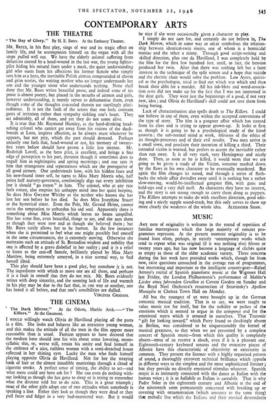MUSIC
ANY note of originality is welcome in the round of repetition of familiar masterpieces which the large majority of concert pro- grammes represent. At the present moment originality is to be found least often, perhaps, in strictly -ontemporary works which tend to repeat what was original (if it was nothing else) fifteen or twenty years ago, but has now become a language of clichés quite as empty as those of the older academic variety. Three concerts during the last week have provided works which, though far from new, raise questions untouched in the average run of programmes, but interesting and important to the intelligent concert-goer—Rafael Arroyo's recital of Spanish pianoforte music at the Wigmore Hall last Friday, the London Philharmonic's performance of Mahler's Lieder eines fahrenden Gesellen at Covent Garden on Sunday and the Boyd Neel Orchestra's resurrection of Stravinsky's Apollon Musagete at Chelsea Town Hall on Monday.
All but the youngest of us were brought up in the German romantic musical tradition. That is to say, we were taught to value music not for itself, but for the nobility or pathos of the emotions which it seemed to argue in the composer and for the emotional states which it aroused in ourselves. That Teutonic "gift for looking inward," which Parry found so shockingly absent in Berlioz, was considered to be unquestionably the kernel of musical greatness, so that when we are presented by a complete concert of Spanish music—from which this quality is completely absent—most of us receive a shock, even if it is a pleasant one. Eighteenth-century keyboard sonatas and the evocative pieces of Albeniz have this characteristic of objectivity or exteriority in common. They present the listener with a highly organised pattern of sound, a thoroughly extrovert technical brilliance which appeals in different ways to the simplest and the most sophisticated listener ; but they provide no directly emotional stimulus whatever. Spanish music is as intimately connected with the dance as Italian with the human voice; it is as ballabile as Italian is cantabile. That is why Padre Soler in the eighteenth century and Albeniz at the end of the nineteenth seem permanently concerned with breaking up or covering with ornamentation (which amounts to the same thing) that melodic line which the Italians and their musical descendants were so concerned to expose and develop. The Spaniards work in masses or conglomerations of sound, strongly dynamic and often formidably conglomerate, as in Fite Dieu a Seville and Triana. Ornamentation is organic, part of the design and not added for purposes of display, so that Albeniz's pianoforte writing is quite unlike the ordinary virtuoso concert style and only remotely related even to the grandest virtuoso music—that of Liszt.
Stravinsky's music for his classical ballet blanc, Apollon Musagete, aims at this same quality of objectivity and exteriority, though he uses exactly opposite methods. Colour is restricted to a minimum, dynamic effect sophisticated almost to extinction and a deliberate archaism interposed like a screen between the composer and his audience. The theory may look well on paper, but in practice the music is painfully arid. It is, in fact, pastiche, adopted as a desperate means of avoiding the all-too-personal relationship between composer and listener as represented, for example, in the Mahler songs given by the L.P.O. at their Sunday concert.
Mahler solicits his listener with winning little gestures, lays his hand on your sleeve and smiles up into your face while he murmurs the hard-luck story of his life in his mixture of Viennese and self- conscious country dialect. It is very touching, if you are susceptible to hard-luck stories and not too squeamish about displays of a per- sonality at odds with the cruel, cruel universe. If not, Mahler's music comes perilously near to a volume of Confessions of a Second- Rate Sensitive Mind. In either case Mahler represented the reductio ad absurdum of the subjective approach to music, and Stravinsky's revolt was historically inevitable, even though for a time it took the barren form of neo-classical pastiche. The problem is still unsolved and not much nearer solution than it was in 1927, when Stravinsky wrote Apolion. In the " classics" it is either not posed at all or answered satisfactorily in a way which is beyond our reach under modem conditions ; but until we achieve our own modem solution contemporary music looks like standing still and gradually fossilising in the " traditions " of the 'twenties and 'thirties.
MARTIN COOPER.



































 Previous page
Previous page